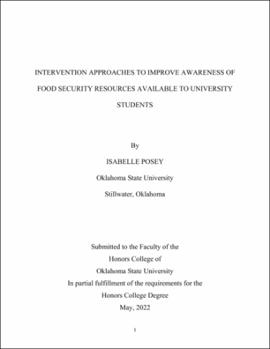| dc.description.abstract | Food insecurity is a prevalent issue in college campuses across the country. The Hunger on Campus study found that 48% of college students face food insecurity. Oklahoma State University (OSU) also experiences high rates of food insecurity. A recent study found that approximately 43.1% of OSU Stillwater students were food insecure and sophomores, upperclassmen, and minority students were at the highest risk. This 2020 study found that food insecure students at OSU were not utilizing the food security resources available to them. The purpose of this mixed methods study was to understand why students are not utilizing the available food security resources and to develop and test the effectiveness of an intervention to promote food resource utilization. The first phase was qualitative and utilized interviews with sophomores, juniors, and senior-level OSU students to identify obstacles preventing resource utilization. Randomized email lists were used for recruitment, and participation was encouraged in ethnically diverse campus organizations. Interviews were transcribed and analyzed for emerging themes. The second phase, the quantitative phase, was informed by the interview results, and included a social media campaign promoted throughout campus using A-Frames. This intervention utilized the social media platform Instagram to promote available resources to students. Student engagement in the intervention was measured by the number of QR scans and Instagram analytics. To measure the effectiveness of increasing resource awareness, a survey was administered to Instagram followers through a direct message. The results of the qualitative phase demonstrated a major limitation in student resource usage is a lack of awareness, and the best way to distribute information on campus was social media and A-Frames. Overall, students at OSU Stillwater are facing food insecurity but are not aware of the resources available; the use of A-frames and social media demonstrate potential to increase awareness. The long-term implication of this study is a reduced prevalence of food insecurity at OSU Stillwater's campus. | |
